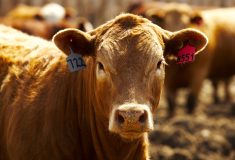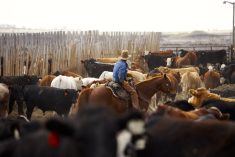Fed cattle
The start of 2022 saw larger numbers of market-ready fed cattle as drought-placed cattle were on feed earlier than typical. At the same time, packing plants faced staffing issues as the Omicron wave peaked. Prices struggled to see a typical start-of-the-year improvement.
At the start of February, feedlots were in a more current marketing position. However, disruptions in the supply and distribution chains led to limited buyer interest, few cattle sold and lower prices the first week of the month. Limited trade at the start of February saw fed heifer prices down $2/cwt from the end of January. There were not enough fed steers marketed through the first week of the month to establish a price. The most recent price recorded was the last week of January at $160.99/cwt, which was $9.80/cwt higher than the same week in 2021 but down nearly $4.75/cwt from the end of December.
Read Also

What to know before you go to Agribition 2025
If you’re attending Agribition 2025, this is the place to find out about tickets, dates and what’s happening this year.
The fed market continued to strengthen in the U.S., which in turn led to a wider Canadian basis. Spot basis at the end of January was -12.80/cwt, over $20/cwt wider than a year ago. When you take into account the higher U.S. prices, the spot basis would be closer to $20/cwt or $25/cwt wider when compared to early February 2021.
COVID-19-related slowdowns at packing plants in January limited worker ability to keep lines steadily moving. As a result, even as a larger number of fed cattle were market-ready, the weekly slaughter numbers through much of January were smaller than last year. Through the first four weeks of 2022, steer slaughter was down three per cent when compared to a year ago at 121,157 head, while heifer slaughter was down four per cent, totalling 82,546 head.
Live export demand has been strong. The first three weeks of the year saw exports of fed cattle, including cows, up 20 per cent to 22,903 head.
Deb’s outlook for fed cattle: In the near term, supply chain disruptions will delay cattle marketing and push feedlots into a less current position with less overall leverage. Depending on how long interruptions continue, market-ready inventory will be pushed forward and prices will be steady at best. However, moving forward into the end of the first quarter and start of the second, fed cattle supply should be manageable. Both domestic and export demand are expected to be strong. Prices are expected to improve and the basis should narrow in the coming months.
Feeder cattle
Heavier feeder cattle have been under seasonal pressure. However, even given the high cost of gain, buyer interest has remained. The 850-lb. feeder steer average at the start of February was $186.23/cwt, down from the January high of $191.56/ cwt but still $8.78/cwt higher than the same week a year ago. Although prices are higher when compared to a year ago, the 850-lb. feeder basis was -$25.16/cwt, which is $23/cwt wider than last year.
High feed costs and grain supply have pressured the lightweight calves. Since the start of 2022, light classes have seen light volumes as well as limited interest. The start of February saw prices down $2/cwt when compared to a year ago, at $223.25/cwt.
Canadian calf prices continue to trade under U.S. calves, leading to increased feeder cattle export numbers in 2022. Feeder exports through the first three weeks of the year were more than double, at 9,470 head, an increase of 107 per cent.
Deb’s outlook for feeder cattle: Optimism remains for the cattle industry in 2022. In addition, U.S. prices remain at a premium to the Canadian market. Both are positive factors in the market.
However, the largest price-limiting factor remains the historically high feed grain prices. In addition to the price, feed barley availability, as well as timely arrival of imported corn, remain troublesome for feeder buyers. Typically, heavier feeder cattle will see prices pressured lower in the coming months. The trend may be the same in 2022; however, feedlots may opt to purchase heavier cattle due to feed costs which will help set a floor on the seasonal decline.
In the next couple of months as spring nears, lightweight calf prices will improve as buyers look at potential grass cattle needs. A wet spring would increase buyer enthusiasm. The wide basis on all classes of feeders will create a floor and increase exports.
Non-fed cattle
The D1,2 cow price average had climbed to $79.14/cwt through January. However, the first week of February prices fell back $1.64/cwt to average $77.50/cwt. The pressure was attributed to the struggle to move boxed beef across the border and very limited on-site space to store additional product. Cow prices in Alberta have been trading consistently under the U.S. market while Ontario cow prices are at their highest point since September 2021.
Demand for domestic non-fed slaughter cattle has been light. However, cow slaughter in Canada is still up seven per cent when compared to January 2021. To the end of the month, there were 40,664 head.
Bull slaughter was small through January, down 51 per cent from a year ago at just 545 head while bull exports through the first three weeks of the year were down 43 per cent to 936 head. The average bull price was over $1.00/cwt higher at the start of February at $102.77/cwt.
Deb’s outlook for non-fed cattle: Beef demand will pick up in the coming month as cow supplies tighten. Prices for trim and grinding beef have increased even as middle meats have come under pressure. Cow prices through the second quarter should rally and spring highs be established. In the meantime, a stronger market south of the border sets a strong export floor.
















